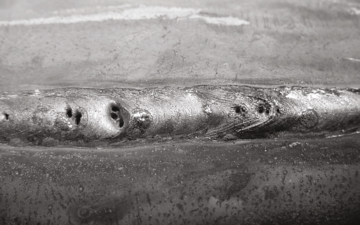Professional Recommendations on What is Porosity in Welding and Exactly How to Address It
Professional Recommendations on What is Porosity in Welding and Exactly How to Address It
Blog Article
Understanding Porosity in Welding: Checking Out Causes, Results, and Prevention Methods
Porosity in welding is a relentless obstacle that can considerably impact the quality and integrity of welds. As professionals in the welding industry are aware, understanding the reasons, effects, and prevention strategies connected to porosity is essential for accomplishing robust and dependable welds. By delving into the source of porosity, analyzing its detrimental effects on weld quality, and discovering reliable prevention strategies, welders can improve their understanding and skills to produce top quality welds regularly. The complex interaction of aspects adding to porosity requires a comprehensive understanding and a proactive strategy to make certain successful welding end results.
Typical Reasons of Porosity
Porosity in welding is largely triggered by a mix of factors such as contamination, improper protecting, and poor gas coverage during the welding process. Contamination, in the type of dust, oil, or rust on the welding surface, develops gas pockets when warmed, leading to porosity in the weld. Incorrect shielding happens when the securing gas, commonly utilized in procedures like MIG and TIG welding, is not able to completely secure the liquified weld pool from reacting with the bordering air, leading to gas entrapment and succeeding porosity. Furthermore, inadequate gas protection, commonly as a result of incorrect circulation rates or nozzle positioning, can leave parts of the weld unprotected, permitting porosity to form. These elements jointly add to the development of gaps within the weld, damaging its stability and possibly causing architectural issues. Understanding and dealing with these typical causes are crucial actions in avoiding porosity and making certain the top quality and strength of bonded joints.
Results on Weld Top Quality
The presence of porosity in a weld can substantially jeopardize the overall top quality and honesty of the welded joint. Porosity within a weld creates voids or dental caries that compromise the structure, making it a lot more prone to splitting, deterioration, and mechanical failure. These spaces work as stress and anxiety concentrators, minimizing the load-bearing capacity of the weld and increasing the chance of premature failing under applied stress and anxiety. In enhancement, porosity can additionally work as potential sites for hydrogen entrapment, more intensifying the destruction of the weld's mechanical homes.
Furthermore, porosity can hinder the effectiveness of non-destructive testing (NDT) methods, making it challenging to find other flaws or suspensions within the weld. This can bring about considerable security issues, especially in essential applications where the structural honesty of the bonded components is vital.

Avoidance Techniques Overview
Given the damaging impact of porosity on weld top quality, efficient prevention methods are critical to keeping the structural stability of bonded joints. Among the main prevention strategies is extensive cleansing of the base materials prior to welding. Impurities such as oil, oil, corrosion, and wetness can add to porosity, so ensuring a clean work surface area is important. Proper storage space of welding consumables in dry conditions is likewise critical to prevent dampness absorption, which can click for more info result in gas entrapment throughout welding. In addition, selecting the suitable welding parameters, such as voltage, existing, and take a trip speed, can assist decrease the risk of porosity development. Making sure ample shielding gas flow and protection is an additional critical prevention technique, as not enough gas insurance coverage can cause climatic contamination and porosity. Ultimately, proper welder training and accreditation are vital for executing safety nets effectively and continually. By incorporating these prevention techniques right into welding methods, the occurrence of porosity can be substantially minimized, causing more powerful and extra reliable welded joints.
Value of Correct Shielding
Correct protecting in welding plays a crucial function in avoiding atmospheric contamination and making sure the integrity of bonded joints. Protecting gases, such as argon, helium, or a blend of both, are frequently utilized to secure the weld swimming pool from reacting with components in the air like oxygen and nitrogen. When these reactive aspects come into contact with the warm weld pool, they can create porosity, causing weak welds with lowered mechanical buildings.

Poor protecting can lead to numerous problems like porosity, spatter, and oxidation, compromising the architectural honesty of the welded joint. For that reason, sticking to appropriate securing practices is essential to create high-quality welds with minimal problems and make certain the durability and reliability of the bonded elements (What is Porosity).
Tracking and Control Approaches
Just how can welders properly keep an eye on and regulate over here the welding process to make sure ideal results and avoid defects like porosity? By constantly monitoring these variables, welders can identify discrepancies from the optimal conditions and make instant changes to prevent porosity development.

In addition, applying correct training programs for welders is necessary for checking and regulating the welding procedure efficiently. What is Porosity. Informing welders on the relevance of keeping consistent criteria, such as appropriate gas shielding and travel rate, can aid stop porosity concerns. Regular assessments and certifications can likewise guarantee that welders are efficient in tracking and regulating welding processes
Furthermore, using automated welding systems can improve tracking and control capabilities. These systems can specifically manage welding parameters, decreasing the likelihood of human mistake and guaranteeing consistent weld top quality. By combining innovative surveillance innovations, training programs, and automated systems, welders can efficiently keep track of and control the welding procedure to lessen porosity issues and attain high-quality welds.
Verdict

Report this page